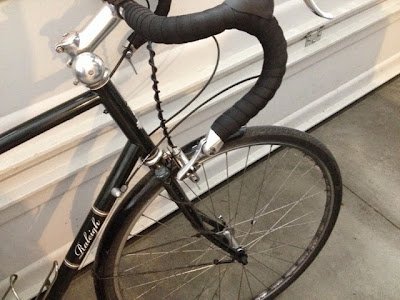Much to my dismay, the Clubman is back... with disc brakes:
Wot wot, guv'nor?
Seriously? The disc brake fad is that pervasive? You have to put them on my beloved Clubman? Although I have to admit that the air under the fenders is promising. Perhaps this Clubman keeps the fat tire clearance of its predecessor. Somebody needs to fire the photo stylist (yes, that's a real job... our Graphic Design Genius did it once, briefly) who set up those fenders with such hideous, uneven spacing around the tires, though.
Lest you think all is lost, the lineup of steel (in what the marketing flacks are calling the Urban All-Road category, sheesh) actually got bigger. There's the Grand Sport which looks to be the real heir to the Clubman mantle, with its steel frame, long-reach caliper brakes, and snazzy orange paint job (though somebody forgot to spec fenders):
Orange you glad it doesn't have disc brakes?
And then, there's another model name from the past, the Grand Prix, although it has some features its predecessor never could have imagined:
A Grand Prix ten-speed. It's like the 1970s never ended.
That's a Campy-equipped steel frame with the same long-reach brakes as the Grand Sport (again, no fenders?), but -- get this -- built with Tom Ritchey's Breakaway travel bike system. So it's pretty much my Clubman, except with some Italian flair and the ability to stuff it in a suitcase to visit Italy. Crazy. (Oddly enough, Ritchey's site has ZILCH in the way of explanation on how the Breakaway system works, but this Adventure Cyclist review does a nice job if you can get past one misuse of "break" vs. "brake". Maybe it was a play on Breakaway. Sure, that's the ticket.)
As you can see in the linked pages from the Raleigh site (from which these images were horked), nothing's posted in the way of geometry or MSRP on any of these yet. My hope is that they chose not to reinvent the wheel and stuck with Clubman geometry across the board... which is pretty much a copy of Rivendell Rambouillet geometry, which is probably a copy of some 1970s Raleigh geometry, so what comes around goes around.
Obligatory disclaimer: I am not a paid Raleigh shill, just an interested observer who saw these bikes on their site and immediately reached for his drool cup. But if they're looking for someone to test any of them (even -- shudder -- that disc-braked abomination), I certainly wouldn't turn down the opportunity... wink wink, nudge nudge, say no more...









